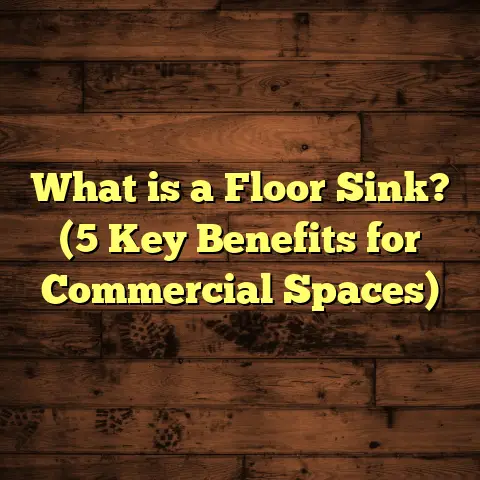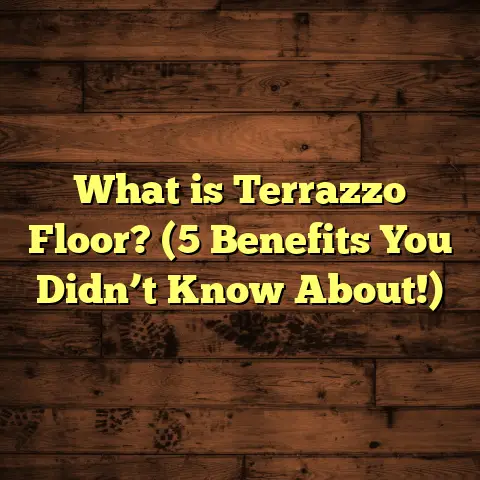What is Old Parquet Flooring? (5 Reasons to Restore It!)
I have to confess—when I first started in the flooring business, I didn’t quite get the hype around old parquet flooring. It seemed like just another type of wood floor, only arranged in patterns. But then, one day, I stepped into a century-old home and saw the parquet in all its glory. That moment changed everything for me. The way the light danced off those tiny wood blocks, the subtle variations in grain and color, the faint marks of decades of footsteps—it was like the floor was alive, whispering stories from long ago. After years of restoring these floors, I can safely say there’s nothing quite like old parquet flooring. If you’ve ever wondered what it really is and why so many people go to great lengths to restore it instead of replace it, pull up a chair. I’d love to share what I’ve learned firsthand.
What Is Old Parquet Flooring?
Let’s start with the basics. Old parquet flooring is a type of wood floor made by arranging small pieces, or “blocks,” of hardwood into decorative geometric patterns. Unlike typical hardwood floors that are laid down as long planks running parallel to each other, parquet is a mosaic of individual wood pieces carefully fitted together.
These patterns can be as simple as a checkerboard or as complex as herringbone, basket weave, chevron, or even custom designs unique to the home. The craftsmanship involved is impressive—each tiny piece is hand-cut and assembled like a puzzle to create a beautiful surface.
The “old” in old parquet flooring typically refers to floors installed decades ago—anywhere from 50 to over 100 years back. These were most common in European aristocratic homes and upscale American houses built before World War II.
The woods used back then were usually durable hardwoods such as oak, walnut, cherry, or mahogany—the kind of wood that ages beautifully and can last centuries with care. These floors have a density and quality rarely seen in modern fast-growth timber.
When I’m called in to work on old parquet floors, what strikes me every time is the level of detail and artistry. The edges of the blocks are often beveled slightly to catch light differently. The patterns create a sense of movement across the floor that you don’t get with ordinary hardwood planks.
How Old Parquet Flooring Was Made
Understanding how these floors were made helps you appreciate why they deserve restoration rather than replacement.
Traditionally, craftsmen would start by preparing a solid subfloor—usually concrete or wooden joists covered with plywood. Then they would meticulously cut small wood blocks, often 1-3 inches square or rectangular. Each block was sanded and beveled on the edges before being laid down using strong adhesives or nails.
Because the patterns had to line up perfectly over large spaces, the installation required patience and precision—no room for rushing! This method also made the floors more stable than long plank hardwoods because the small blocks could better accommodate slight movements in humidity or temperature.
Why Did Parquet Flooring Fall Out of Favor?
You might wonder why such beautiful floors aren’t everywhere today. The truth is, after World War II, building trends shifted toward faster, cheaper flooring options like linoleum and vinyl. Mass-produced hardwood planks became more popular too because they were easier and faster to install.
Parquet flooring was seen as old-fashioned and expensive to install and maintain. Many homeowners covered their parquet floors with carpets or replaced them altogether. This led to many beautiful floors being hidden away for decades.
But in recent years, there’s been a resurgence of interest in restoring old parquet floors as people realize their timeless beauty and durability.
5 Reasons Why I Always Recommend Restoring Old Parquet Flooring
1. The Unique Beauty Is Hard to Match
There’s something about parquet that immediately catches your eye. The patterns add visual interest and texture that regular hardwood floors don’t have. When light hits those tiny blocks at different angles, it creates depth and warmth that feels inviting.
Years ago, I worked on restoring an old Parisian apartment’s original parquet floor laid in an intricate Versailles pattern. The owner had been hesitant about spending money on restoration but agreed after seeing some sample finishes I brought over.
When we finished sanding and sealing the floor, it looked spectacular—like a piece of art underfoot. Visitors kept commenting on how elegant and cozy the room felt. That kind of reaction is hard to get from modern flooring materials.
The natural color variations between blocks—sometimes subtle shifts from golden oak to deep brown walnut—give each floor a unique personality. No two parquet floors are exactly alike, especially when they’ve aged naturally over decades.
2. Environmentally Friendly and Sustainable
From my experience, one of the most overlooked benefits of restoring old parquet floors is their sustainability factor.
A lot of people don’t realize that tearing out old flooring contributes significantly to landfill waste. According to the Environmental Protection Agency (EPA), construction and demolition debris accounts for about 600 million tons of waste annually in the U.S., with flooring materials making up a large portion of that.
When you restore an existing parquet floor instead of replacing it, you’re keeping valuable hardwood out of landfills and reducing demand for freshly cut timber. The National Wood Flooring Association highlights that reusing wood floors cuts carbon emissions dramatically compared to manufacturing new flooring products.
Additionally, old-growth hardwood used in parquet has tighter grain patterns and higher density than fast-growth trees used today. This means restored old parquet floors last longer and perform better—less need for replacement means fewer resources consumed over time.
I always encourage clients who care about their environmental footprint to consider restoration not just for beauty but because it’s a responsible choice.
3. Cost-Effectiveness When You Look at Longevity
I won’t sugarcoat it—restoring old parquet floors isn’t cheap upfront. The process often involves stripping layers of old finish or paint, sanding carefully around delicate edges, repairing broken blocks, filling gaps, and applying high-quality finishes.
But here’s the thing: once restored properly, old parquet floors can last 50 years or more with routine maintenance.
Compare that with cheaper flooring options like laminate or vinyl that often need replacement within 10-15 years—and suddenly restoration looks like a smart investment.
I use tools like FloorTally regularly to help estimate costs accurately for restoration projects based on local labor rates and materials. It’s saved me from underestimating time or waste—and helped clients understand where their money goes.
A typical professional parquet restoration runs between $4-$8 per square foot depending on damage severity and location. New engineered hardwood flooring might be cheaper upfront but expect ongoing replacement costs that add up fast.
4. Boosts Your Home’s Market Value
Historic homes with original features tend to attract buyers who appreciate authenticity and craftsmanship—and they’re often willing to pay more for it.
According to research by the National Association of Realtors, homes featuring well-maintained original hardwood floors sell faster and command prices 5-10% higher than comparable homes without them.
When I restored an original parquet floor in a 1920s Brooklyn brownstone last year, the owners planned to sell soon after. Their real estate agent told them the restored floor was one of the main selling points and helped justify a higher asking price.
If you plan to stay in your home long term or sell someday soon, restoring your parquet floor can be both emotionally rewarding and financially wise.
5. Character That New Flooring Can’t Match
Old parquet floors come with quirks—tiny gaps at joints where wood has expanded or contracted over decades; slight color changes caused by sunlight exposure; faint dents from family life—all these imperfections make the floor feel lived-in and loved.
During one job at an early 1900s cafe in Chicago, we found small burn marks on parts of the parquet from where hot pans accidentally touched it decades ago. Rather than trying to hide those marks completely, we blended them into the finish as part of the floor’s story.
Modern pre-finished floors are flawless but sterile by comparison—they lack that lived-in charm that only time can create.
Common Challenges with Restoring Old Parquet Floors
Restoration isn’t always straightforward. Here are some hurdles I’ve faced repeatedly:
- Loose or Missing Blocks: Over time, some blocks may come loose due to worn adhesives or structural movement. These need careful removal and reglueing.
- Water Damage: Parquet isn’t waterproof. Water leaks can cause warping or swelling of blocks.
- Paint or Stain Layers: Many old parquet floors have been painted over or stained multiple times during previous renovations.
- Uneven Wear: Areas near doorways or heavy furniture might be more worn down than others.
- Matching Wood Species: Finding replacement blocks that match original wood color and grain can be tricky but sourcing reclaimed wood helps.
I always recommend hiring professionals experienced in parquet restoration because improper sanding or repairs can damage these delicate floors beyond repair.
Step-by-Step Overview of How I Restore Old Parquet Floors
Here’s a rough outline based on my typical restoration process:
- Inspection: Assess damage extent including loose blocks, water stains, paint layers.
- Preparation: Remove furniture and coverings carefully.
- Cleaning: Use gentle solvents or chemical strippers if paint/stain layers exist.
- Repairs: Replace broken blocks using reclaimed wood; reglue any loose pieces.
- Sanding: Start with coarser grit sandpaper (36-40 grit) carefully around edges; progress through finer grits (up to 120-150 grit) for smooth finish.
- Filling Gaps: Use color-matched wood filler sparingly.
- Sealing & Finishing: Apply multiple coats of polyurethane or oil-based finish depending on client preference.
- Final Buffing: Enhance smoothness and sheen.
- Maintenance Advice: Educate homeowner on cleaning routines and humidity control.
How I Use FloorTally for Accurate Cost Planning
Estimating costs accurately is crucial for any flooring project but especially for something as intricate as parquet restoration where surprises happen often.
FloorTally helps me by:
- Calculating precise material quantities including waste factors based on room dimensions.
- Inputting local labor rates so estimates reflect real-world prices.
- Allowing me to compare different finishing options side-by-side.
- Visualizing total project costs clearly so clients feel confident before starting work.
This tool saves me hours of manual calculations and reduces errors that can lead to budget overruns.
Personal Anecdotes from Restoration Projects
One project that sticks out happened in an old farmhouse in Vermont. The owners had inherited the house but never appreciated its value until I showed them photos of other restored parquet floors I’d done.
The floor was covered by decades-old linoleum glued directly onto the wood blocks! Removing it was painstaking but rewarding—the original pattern underneath was still intact but dirty and scratched.
After thorough sanding and refinishing with an amber-toned oil finish, the floor burst back to life like something out of a history book.
The owners told me they could now “feel the soul” of their home every time they walked into the room—a phrase that stuck with me ever since.
Maintaining Your Restored Parquet Floor
Restoration is just part one—the real secret is how you care for your floor afterward:
- Sweep or dust mop daily with microfiber tools.
- Avoid wet mops; water damages wood fibers.
- Use rugs or mats at entrances to trap dirt.
- Keep pet nails trimmed to avoid scratches.
- Control indoor humidity between 35-55% using humidifiers/dehumidifiers if needed.
- Reapply protective finishes every 10-15 years depending on wear.
Following these simple steps will keep your beautiful parquet looking great for decades more.
Old parquet flooring isn’t just about having a pretty surface beneath your feet—it’s about preserving artistry, history, and character that can’t be replicated by modern materials.
If you’re lucky enough to have this kind of floor in your home—or are considering installing reclaimed parquet—I hope my experience helps you appreciate why restoration deserves serious thought.
Got questions about your own floor? Feel free to ask—I’m always happy to share tips or help troubleshoot tricky situations!





